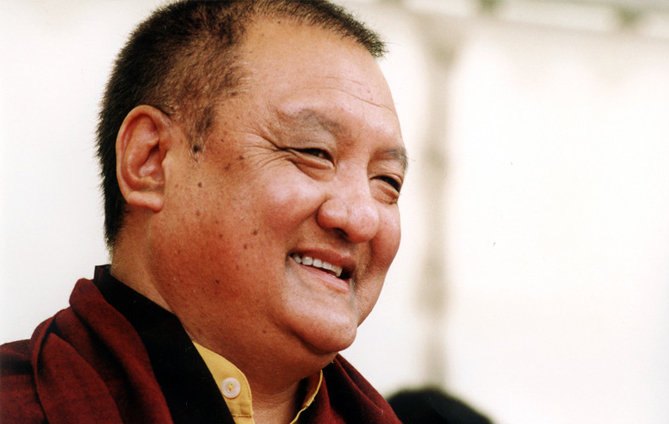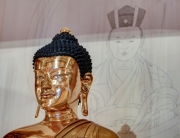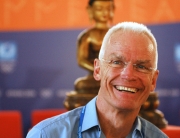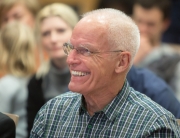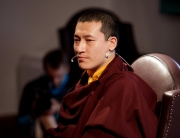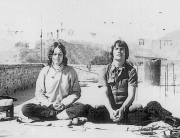The term view means the right understanding of the Buddhist path. Meditation is the actual practice, and conduct is the discipline necessary to stay on the path. The view is a very profound guide to meditation. Without proper knowledge of the teachings, many obstacles arise due to mistakes in the practice. Naturally, if you do not know anything about meditation you won’t recognize them as mistakes. This is why before you start practicing, you should develop correct understanding. Then you can recognize obstacles and the meditation will progress. In this way view and meditation are connected.
Conduct is based on the understanding of karma. Right conduct means to ensure that actions, whether through body or speech, are not influenced by disturbing emotions. If actions are biased, negative karma is created. For example, we bring harm to people and possibly even kill others, if we let ourselves be influenced by anger. With the motivation of anger, a great deal of negativity and ill will arises. Right conduct means to be free of those influences and instead, let our actions be guided by positive qualities like compassion.
Like meditation, conduct is also influenced by the view because right understanding leads naturally to right conduct. Some people have problems with this. For example, if one understands the teachings with the right view but does not follow them, it brings about difficulties with one’s own emotions. Even learned people can act negatively, because a person can have the right understanding without the right meditation. Meditation is the means to conquer negative emotions and right view provides the understanding of how to conquer them. If we want to become liberated, then our own negative emotions are our real enemy.
We can learn how to overcome disturbing emotions by studying the Abhidharmakosha. This text explains in detail how to overcome negative emotions, and even how long it will take. Such teachings can also be found in the Prajnaparamita and on the Vajrayana level, in the Sabmo Nang Gi Don. Here it is calculated that it takes three years, three months and three days to remove all samsaric problems through practice. To study such texts is to become a learned person and to understand the path. However, someone who has completed a three year retreat could be seated on a stage and recite everything by heart without necessarily being enlightened at all. In this case emotions are still stronger than knowledge because of not following the path personally. Emotions can overpower the view if the emotions are not overcome through meditation.
There are many different obstacles on the path. Through these you will find out what kind of Dharma practitioner you are. To meditate, you need the right understanding or you will make many mistakes. Meditation without understanding is very risky. You may know a little bit about meditation, but this is not sufficient to develop your practice over a long period of time.
It is not enough to simply imagine what is best. Overcoming obstacles is about cause and effect and the knowledge that things are connected. Conduct generally has to do with karma. The specific behavior to be applied depends on the developed level of practice. In Vajrayana, samaya is important. Beyond the meaning of receiving the empowerment and practicing a certain buddha aspect, samaya means proper conduct. It is concerned with avoiding any behavior that could harm one’s own practice. For example, if you intensively practice meditation for calming the mind (Tib. shi-ne, Skt. shamata) while thinking that you would rather be doing a higher practice like Mahamudra, this is a mistake. It is not right conduct to practice something before having successfully built the foundation. Of course, it is a positive intention to want to practice a higher teaching like Mahamudra. But here it is a hindrance. You cannot successfully practice shi-ne now and even more so Mahamudra later. It is also said that you should not eat too much if you practice shi-ne intensively. If you eat a lot and get sleepy, you cannot practice meditation of calming the mind well. That is why the Buddha said that monks should not have an evening meal.
View, meditation, and conduct are therefore practically connected. Buddhism does not simply prescribe something to people but teaches practical things in order to achieve results. There are no arbitrary rules, for example, that you must wear a certain hat in order to be part of the religion, even if I do have a red crown (Shamar Rinpoches traditionally wear a red hat.)
Right view in the widest sense means to understand the meaning of the Madhyamaka. Madhyamaka is the essence of all the high practices of Mahamudra and Maha Ati. None of these high meditations can be practiced without understanding the Madhyamaka view. Perhaps there are other high meditations that I do not know about, but these are meditations which lead to Buddhahood. The Madhyamika first explains the right view. Based on this, special methods have been compiled and have been given names like Mahamudra and Maha Ati. These meditations are represented separately from the view of the Madhyamaka. For example, the ritual execution of the Chod practice* – how one actually plays the big damaru (a ritual drum) and so on – are not described in the Madhyamaka. But, without Madhyamaka view one cannot do this practice. There is more to it than just the music.
In Mahamudra and Maha Ati there is much said about the nature of mind. This means that when the meditator recognizes the actual meaning of Mahamudra or Maha Ati he will be enlightened on the spot. Just try to do that. We make jokes about it. Many people who study these teachings say, “Mahamudra and Maha Ati are the highest meditations. I have studied them for many years and now I know.” But that would mean that they have been enlightened for a long time. To recognize the nature of mind is to become enlightened. In the teachings of Maha Ati it is said that to begin this practice in the evening one is enlightened the next morning. Starting in the morning then one is enlightened in the evening. That is only twelve hours, isn’t it? If someone says that he knows it because he studied it for many years, but he is still not enlightened, then what does he really know? It is not so easy.
You may have heard that you should see the guru as the essence of all buddhas. Let’s say I agreed to be your guru and to show you the nature of your mind. Maybe you would get very excited because it would be very direct and special. Afterwards you would go home and say, “Today I received a profound meditation from my guru.” But look at yourself – what actually changed in you? You should then come back to view, meditation and conduct.
Milarepa received the teachings from Marpa and then practiced alone. His conduct was to practice twenty-four hours a day in his cave, fully concentrated. But he also sang many songs. Often he meditated and afterwards sang a song. Why did he do that? His knowledge of meditation guided his practice and so he sang songs often to remind himself. In the course of his practice certain methods were necessary at certain times so he composed a verse to rekindle his knowledge from memory. Although he never studied it, he was very good at composing poetry. Whenever it was necessary for his meditation he composed a precise poem. If you read the life story of Milarepa you will find that he sang songs at important junctures in his practice. When he had obstacles he recalled various methods from memory. In this way Milarepa’s knowledge guided his meditation.
The Madhyamaka teaches precisely and logically that phenomena and beings don’t really exist, what mental confusion consists of, and how illusion arises in the mind. It teaches how, if you practice, you can become free from neuroses, attachments, and the habit of believing in concrete existence. You can remove all this because you understand it very precisely within the Madhyamaka view. According to the Madhyamaka view of emptiness, all substantial phenomena are heaps (Skt. skandhas) composed of particles. Then, this is examined metaphysically by dividing everything up until you find that even the smallest particles or atoms don’t have real existence. Then you examine mental projections in the same way. It is explained that mind itself is emptiness, that it is an accumulation of momentary thoughts, none of which exist independently but arise in dependence upon one another. Therefore mind doesn’t have a solid existence either. That is how the Madhyamaka explains emptiness. But then, if we punch the wall, our hand still hurts. Although you understand through logic that there is no real existence, you do not yet experience what it really means. It is not about simply explaining everything as nonexistent. Logic alone is not enough to remove illusion. On the basis of the Madhyamaka view, meditations which build on one another in a certain way have to be practiced.
What will one achieve through this? The Madhyamaka explains that all things are empty. But we don’t want to achieve sheer emptiness – what would be the benefit of that? What emptiness is all about is to achieve a deeper understanding of mind through Mahamudra, the core of the Madhyamaka. It is neither the outer world that imprisons us in samsara nor our body. Neither the universe nor our bodies are in samsara – our mind is. The point is to examine mind with the precise logic of the Madhyamaka. When you are oriented properly towards the mind, you have the correct view. To apply this view of the mind as practice, simply let the mind experience this very view. Then you have Mahamudra experience in one instant.
To experience Mahamudra, great concentration is necessary. That is why it is so important to practice shi-ne first. Without the stability of shi-ne the view of mind is like a flame in the wind. One moment it is there, the next it is gone. If you try to have the right view without mental stability, then perhaps a short insight arises but the untamed mind is unable to maintain it. Before you are able to hold the view without interruption, statements like “one can achieve enlightenment in one instant” make no sense.
Develop the view first, then on this basis develop direct experience of the mind and practice it without interruption. When the right view of mind is developed it is an awakening from ignorance. But the view must be held continuously. Without mental stability it will disappear again.
*A tantric practice for killing the ego by symbolically offering one’s body.


